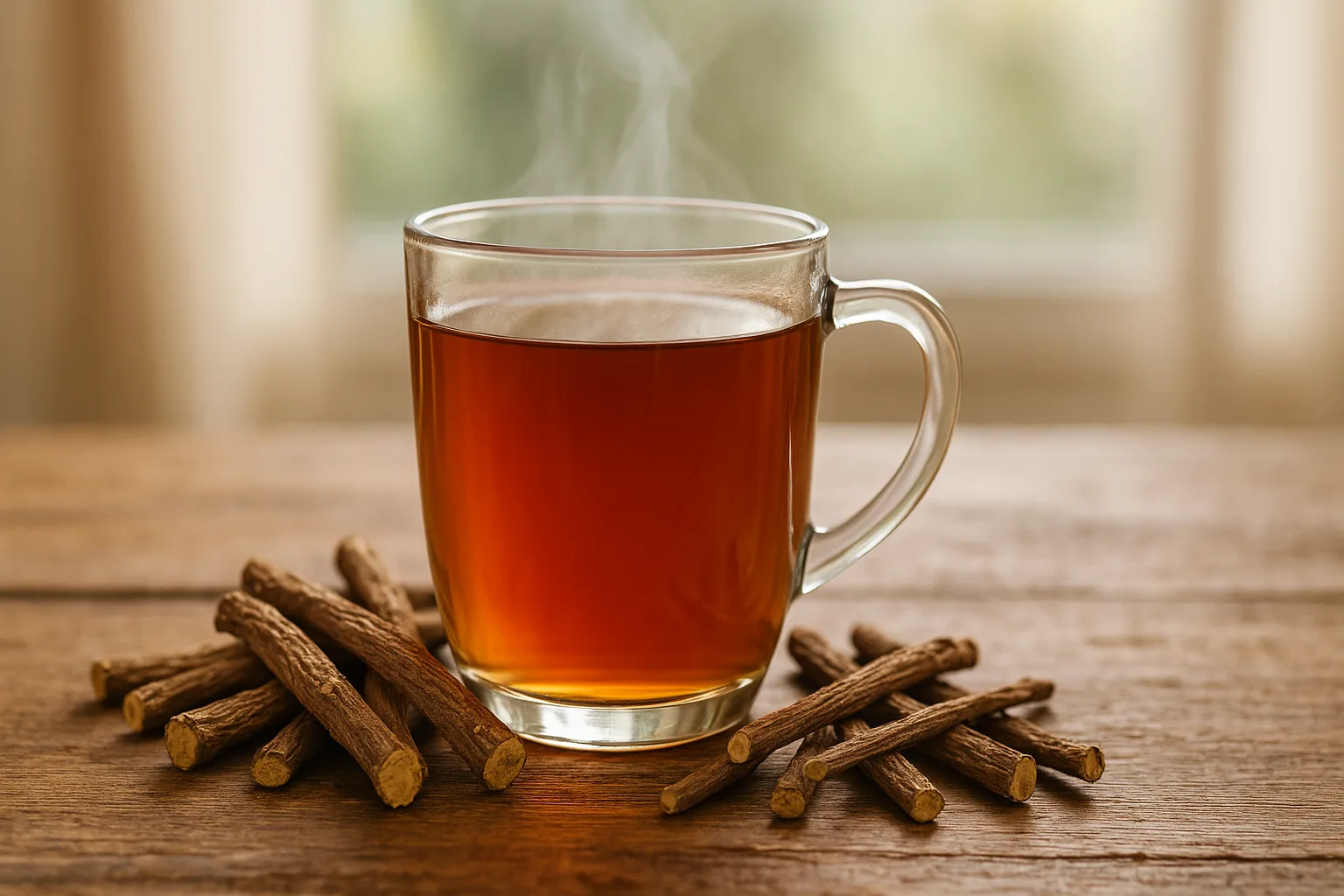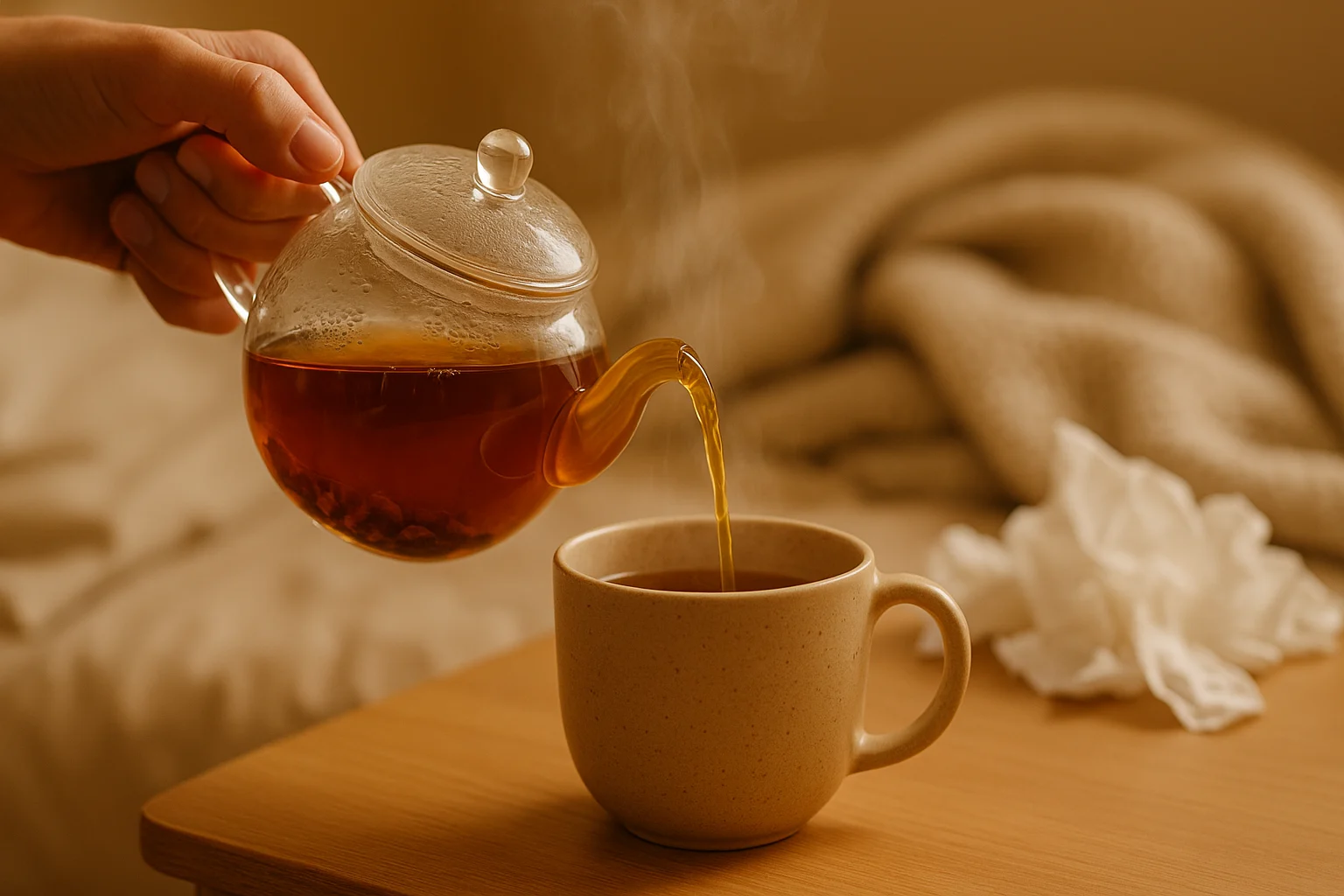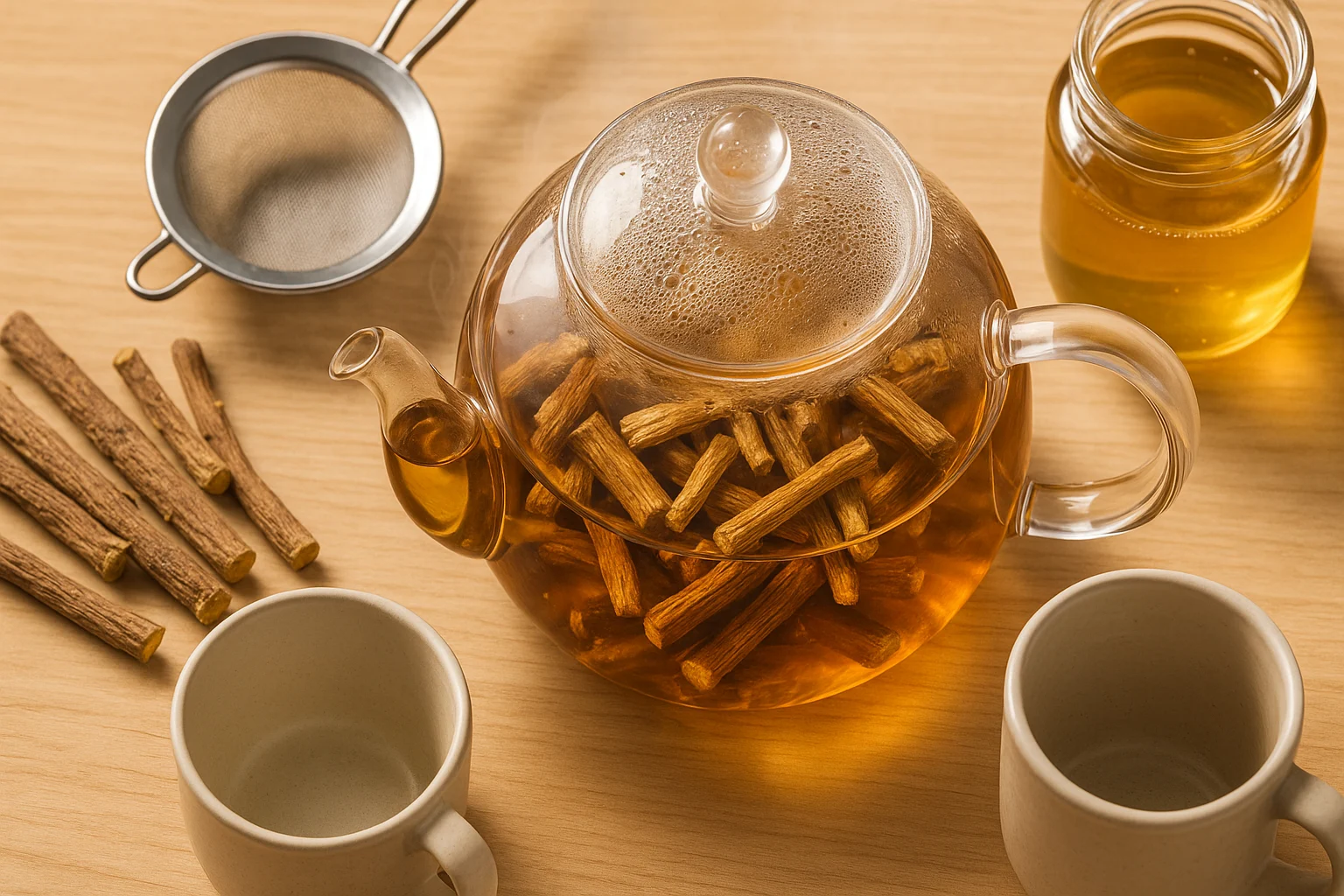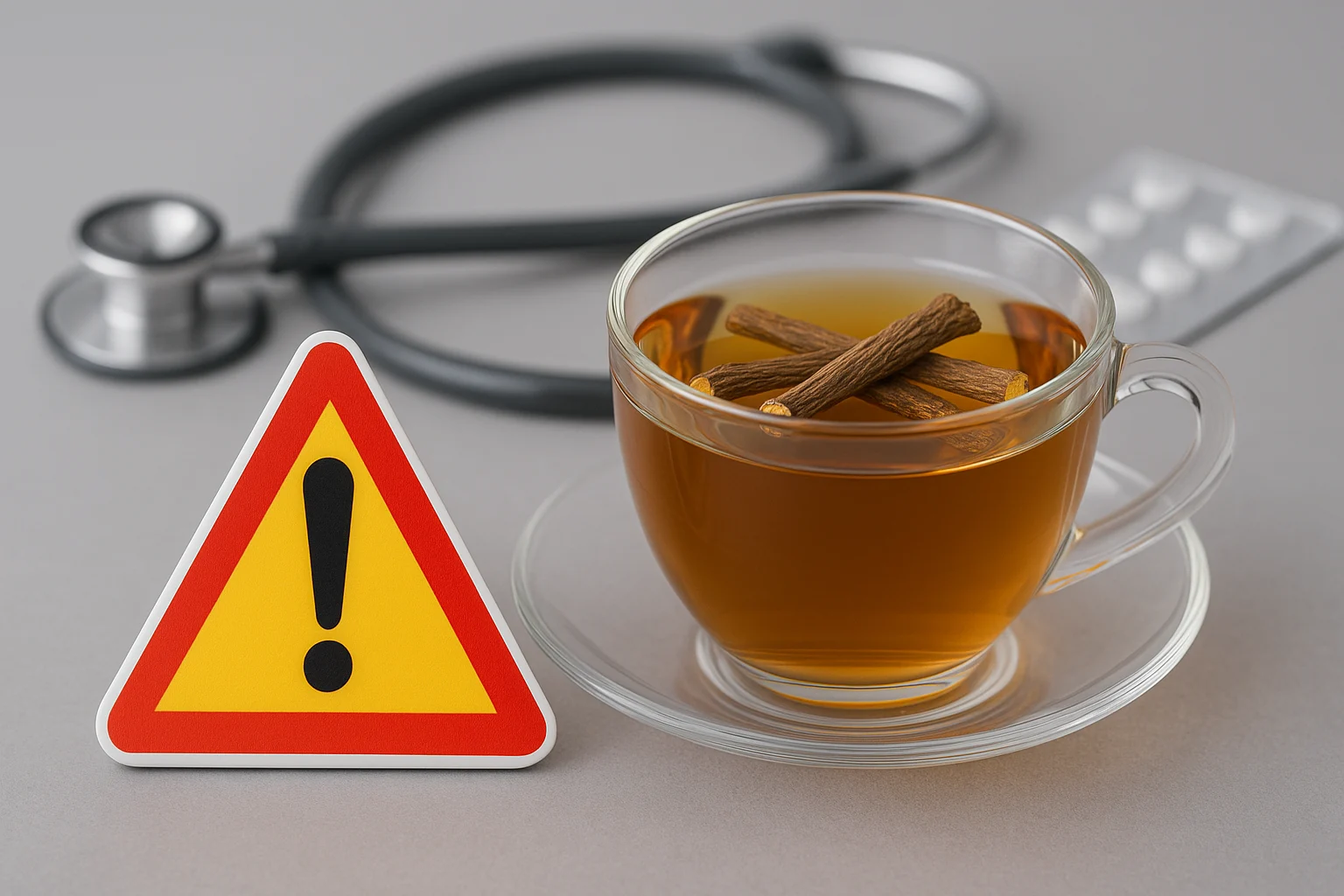
Could a sweet, earthy tea transform your wellness routine? For centuries, licorice benefits tea has been cherished for its ability to soothe sore throats, calm upset stomachs, and ease stress — but it’s not for everyone. Discover how the benefits of licorice tea can fit your routine. Derived from the root of the Glycyrrhiza glabra plant, this ancient herbal ally offers a wealth of potential wellness perks. However, understanding safe use is crucial. In this guide, we’ll explore benefits, safe brewing, and who should avoid it — as part of our broader Ayurvedic Wellness Guide.
Try the Timing GuideThis page contains paid/affiliate links. As an Amazon Associate I earn from qualifying purchases, and we may earn commissions from other partners—at no extra cost to you. Learn more.
Table of Contents
Key Takeaways of Licorice Benefits Tea
- Health benefits include relief for sore throats, digestion, and stress, thanks to compounds like glycyrrhizin.
- Brewing requires steeping dried licorice root or tea bags; avoid boiling to preserve beneficial compounds.
- Regular licorice tea contains glycyrrhizin, which can raise blood pressure, while DGL (deglycyrrhizinated) licorice is safer for long-term use.
- People with high blood pressure, pregnant individuals, or those on certain medications should avoid regular licorice tea.
- Always consult a healthcare professional before adding licorice benefits tea to your routine, especially if you have health conditions.
Licorice Tea Health: Top Benefits
Licorice root has a storied history in traditional medicine, from ancient Egypt to China. Today, science supports some of these uses, making licorice tea’s role in digestive health a priority for many wellness enthusiasts. If you want the deep dive, see our guide on licorice root benefits. Here’s how it can help your health.

Soothes Sore Throats and Respiratory Issues 🌬️
Licorice tea can calm a sore throat and make breathing feel easier. It’s a small, cozy ritual—and a simple win for licorice tea wellness when cold season hits. I reach for it when my throat is scratchy, and relief usually comes fast.
- Anti-inflammatory help: May ease swelling and throat pain.
- Expectorant support: Helps loosen mucus for easier coughing.
- Demulcent coating: Gently lines irritated tissues like a natural syrup.
Licorice Tea Wellness for Digestion 🍏
If your stomach feels unsettled, licorice benefits tea can be a gentle ally for digestion. It’s a simple habit that often takes the edge off.
- Heartburn and Acid Reflux: Licorice strengthens the stomach’s mucus lining, protecting against acid. A 2011 study supports its role in reducing reflux symptoms.
- Stomach Ulcers: It may inhibit Helicobacter pylori, a bacterium linked to ulcers, and promote healing.
- General Comfort: Licorice may reduce bloating and indigestion by calming inflammation.
For ongoing digestive issues, many people prefer DGL licorice—it reduces the glycyrrhizin-related risks.
How to Brew Licorice Tea Correctly
Brew licorice tea the right way and you’ll get the good stuff without losing potency—whether you use dried root or tea bags.

Whole Root vs. Tea Bags
Both work—pick what fits your routine.
- Whole Root: Offers a richer flavor and full compound spectrum. Available at herbal shops or online.
- Tea Bags: Convenient for quick brewing. Check labels for pure licorice or desired blends.
Ingredients & Equipment
- For Whole Root:
- 1 tsp to 1 tbsp dried licorice root
- 8–10 oz filtered water
- Small saucepan, strainer, mug
- For Tea Bags:
- 1 licorice tea bag
- 8–10 oz filtered water
- Mug
Step-by-Step Brewing Guide
Whole Licorice Root:
- Rinse root under cold water to remove dust.
- Simmer (don’t boil) root in 8–10 oz water in a saucepan.
- Steep on low heat, covered, for 10–15 minutes (up to 20 for stronger flavor).
- Strain into a mug and enjoy.
Licorice Tea Bags:
- Boil 8–10 oz filtered water.
- Place tea bag in mug, pour hot water over it.
- Cover and steep for 5–10 minutes.
- Remove bag and sip.
Flavor Enhancement Tips
This tea’s sweet, anise-like flavor is unique. Enhance it with:
- Honey 🍯: Adds sweetness and soothes throats.
- Lemon 🍋: Brightens flavor with Vitamin C.
- Ginger: Adds warmth, great for colds.
- Mint: Refreshes the palate.
- Cinnamon: Deepens flavor with warmth.
Explore other Ayurvedic teas to enjoy herbal tea benefits alongside licorice.
Trying other herbal teas beyond licorice can round out your daily routine.
Use organic licorice root and filtered water for the best taste and potency.
My Favorite Licorice Teas for Wellness
Top 3These are my go-to teas for their soothing flavor and quality—perfect for sore throats, digestion, or a cozy moment.
Yogi Egyptian Licorice
Naturally sweet and cozy — perfect for everyday comfort.
- Best for: Everyday comfort
- Format: 16-ct
Yogi Egyptian Licorice Mint
Cooling mint + licorice — lovely when the throat feels scratchy.
- Best for: Throat & congestion
- Format: 16-ct
Traditional Medicinals Licorice Root
Pure licorice root — simple, clean formula.
- Best for: Straight single-herb
- Format: 16-ct (6-pack)
Gentle DGL for Digestion • alternatives
DGL = deglycyrrhizinated licorice — a lighter option many people use for digestion.
- DGL Licorice Chewables — simple “before meals” routine for reflux/after-meal comfort. View on Amazon
- DGL Licorice Liquid (Alcohol-Free) — easy micro-dosing; add to water/tea without extra sweet. View on Amazon
When to Enjoy Licorice Benefits Tea
Timing depends on your goal and the tea type (regular vs. DGL).
General Guidelines
- Sore Throat/Cough: Sip as needed during symptoms.
- Digestion: Drink 20–30 minutes before or after meals. DGL is ideal for chronic issues.
- Stress: Morning or early afternoon to avoid stimulation at night. Combine it with breathwork for anxiety for deeper calm.
Dosage and Duration
- Regular Licorice: 1–3 cups daily for 4–6 weeks, then take a break due to glycyrrhizin risks.
- DGL Licorice: Safer for daily use, especially for digestion, but moderation is key.
Licorice Tea Timing Guide 🕒
Licorice Tea Timing Guide
Choose your health goal to find the best time to enjoy licorice tea.
Select a goal to see the best timing for licorice tea.
💡 Choose a goal to get personalized timing tips!
Timing Legend
Who Should Avoid Licorice Tea?
While licorice tea offers many advantages, it’s not suitable for everyone. Regular licorice (with glycyrrhizin) can affect blood pressure and electrolytes, while DGL is safer.

Glycyrrhizin Side Effects
Glycyrrhizin can disrupt sodium and potassium balance, leading to:
- Increased Blood Pressure: Even healthy individuals may see rises with regular use.
- Fluid Retention: Causes swelling in ankles or feet.
- Hypokalemia: Low potassium that can trigger muscle weakness or heart rhythm issues.
If you have high blood pressure, avoid regular licorice tea and ask your clinician whether DGL is appropriate.
Pregnancy and Breastfeeding 🤰👶
Pregnant or breastfeeding? Skip regular licorice tea because of glycyrrhizin. DGL might be an option, but only with your provider’s okay.
Kidney, Liver, and Heart Conditions
Kidney, liver, or heart conditions (especially arrhythmias) are a red flag—regular licorice can strain these systems and disturb potassium.
Medication Interactions 💊
Licorice tea can clash with certain drugs:
- Blood-pressure meds: May blunt their effect
- Diuretics: Can worsen potassium loss
- Corticosteroids: May amplify side effects
- Digoxin: Can raise toxicity risk
If you take medications, talk with your clinician first.
Long-Term Use Risks
Keep regular licorice tea to short stretches (about 4–6 weeks), then take a break. DGL is generally safer for longer use, especially for digestion.
When in doubt, ask a healthcare professional before adding this tea to your routine.
DGL vs. Regular Licorice Tea
Understanding the difference is key to safe use:
- Regular Licorice: Contains glycyrrhizin, offering benefits but risking blood pressure and electrolyte issues.
- DGL Licorice: Glycyrrhizin is removed, making it safer for long-term digestive support without blood pressure concerns.
Check labels to ensure you’re choosing the right type for your needs.
Frequently Asked Questions About Licorice Benefits Tea
Conclusion
Licorice tea blends old-school wisdom with modern wellness—from soothing sore throats to supporting digestion and stress relief. Whether you choose regular or DGL licorice, using it wisely helps you enjoy herbal tea benefits with confidence. Brew it well, time your cups, and you’ll get more from every sip. If you have any conditions or take medications, check with a professional first. Here’s to a calmer, cozier cup! 🍵
Explore Tea OptionsQuick Recap — My Favorite Licorice Picks
Disclaimer: This content is for informational purposes only and does not constitute medical advice. Always consult a qualified healthcare provider before using licorice tea, especially if you are pregnant, nursing, taking medication, or have a medical condition.


